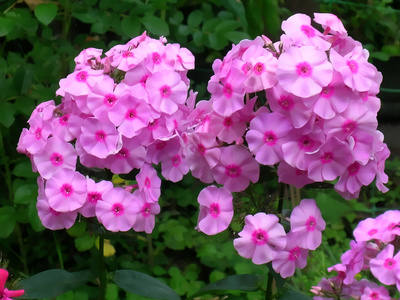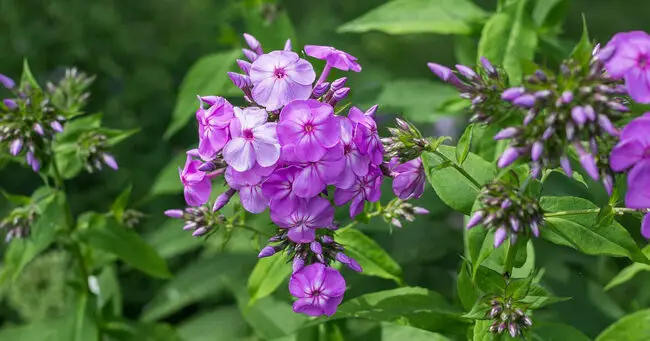Each year, in late fall, the Phlox must be cut back, prune the stems to 2 or 4 inches from the ground. You can also prune the phlox during the growing season to keep a more compact, stocky habit.
Contents
When and how to prune Phlox ?
Whether annual or perennial phlox, maintenance is relatively easy and usually consists of watering when the soil is dry.
For phlox in pots, tubs or planters, more regular watering is required.
Annual Phlox :
The best known of the annual Phlox is the phlox drummondii.
It likes the sun and rather rich and well drained soils.
Regular watering is necessary, especially in periods of drought.
Perennial Phlox :
The phlox has many species and varieties but we can say that they all prefer the sun.
Therefore, prefer sunny or partially shaded situations for a few hours.
Make sure that your soil is rich enough for a beautiful flowering.
At the beginning of spring bring flowering plant fertilizer to your soil.
Remove wilted flowers as you go.
Phlox in winter :
The perennial phlox grows back from year to year but it is preferable, as soon as the first frosts, to cut short the foliage which will have blackened and to protect them from a good mulch of dead leaves.
You will be able to pull out the annual phlox that will not grow back the following year.
Diseases and pests
Phlox are solid perennials that live long in our gardens. It is quite common for them to be affected by powdery mildew in summer. This cryptogamic disease, which is not a real hindrance for the cultivation of phlox, results in the appearance of a white felting on the foliage. The most susceptible seem to be Phlox paniculata, while Phlox divaricata and maculata are more resistant. But even among Phlox paniculata, some varieties are more resistant than others.
These include ‘David’, ‘Eva Cullum’, ‘Bright Eyes’, ‘Peppermint Twist’ and ‘Robert Poore’. To prevent powdery mildew, it is best to avoid planting too densely, so that air can circulate, and water by directing the spray at the base of the plant, without wetting the foliage. Once the disease has been noticed, you can remove the affected leaves to limit its development, and treat using sulfur.

How to treat powdery mildew on a Phlox ?
It is affected by powdery mildew, a disease caused by a fungus. We suggest that you remove and burn the affected leaves and then treat by spraying with sulphur. When watering, direct the spray at the base of the plant to avoid wetting the foliage.
They can also be attacked by eels (usually in summer): these are microscopic worms that enter the stems and cause the plant to die. The stems twist, become swollen and brittle, the flowering is poorer, and the foliage becomes distorted. You can remove the affected plants to prevent the nematodes from reaching the plants that are still healthy.
As for other pests, phlox can be attacked by leafminers, and slugs and snails sometimes nibble on young shoots that are still tender.
How to propagate Phlox ?
Phlox can multiply by seeding, cutting and dividing. For perennial species, division is recommended, while sowing is more suitable for annual phlox. Phlox divaricata tends to spontaneously layered when its stems touch the ground, and Phlox stolonifera spreads thanks to its runners. In these two species, it is thus easy to take fragments to multiply the plant.
Sowing:
You can recover the seeds of the phlox to resow them in spring.
Sow the annual species (especially Phlox drummondii) directly in place around May.
Work the soil to obtain a fine seedbed, without clods, large stones or weeds, and take the opportunity to bring some compost.
- Sow by spreading the seeds on the surface.
- Cover them with a thin layer of soil.
- Sprinkle in a fine rain.
- Keep watering regularly. It will then be necessary to thin out.
- Sow the panicle phlox in March, under cover.
- Fill a pot with potting soil and press down lightly.
- Sow the seeds 2 or 3 cm apart.
- Cover them with a thin layer of substrate.
- Pack and sprinkle.
- Place the pot under a cold frame.
Make sure that the potting soil remains moist until germination. You can install them in the garden around May.
Cutting:
You can multiply Phlox subulata by cuttings. It is best to disinfect the tools beforehand to avoid spreading diseases.
Phlox paniculata is easily multiplied by cutting roots around December.
- Prepare a box by placing a mixture of soil and sand in it. Then moisten the substrate.
- Dig up a strain of phlox, taking care not to damage the roots.
- Remove the soil to expose a root (you can rinse it with water if necessary), and cut it into segments four or five centimetres long, each with a few small roots. Make clean, neat cuts.
- Place them in the box, horizontally.
- Cover them with a few centimeters of substrate.
- Put your cuttings under cover, frost-free.
The substrate must be kept cool, but not excessively moist. You will be able to plant your cuttings in the ground around April.
You can also make stem cuttings, in autumn, after flowering:
- Collect segments of about 10 cm in length.
- Remove the basal leaves, to keep only those on the top of the stem.
- Soak the base of the stem in cuttings hormone.
- Plant in a pot filled with soil, previously moistened.
- Pack all around.
- Place a plastic bag over the pot, in order to suffocate the cutting (humid atmosphere).
Summary
The Phlox must be cut, each year, in late fall, to proceed, we advise you to cut the stems between 2 and 4 inches from the ground. Indeed, they are herbaceous plants, annual or perennial, which come almost mainly from North America. They gather a little more than 80 species. Most of the cultivated species, of which the Phlox paniculé, are originating in the United States.









